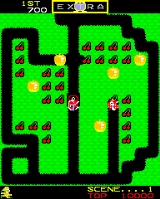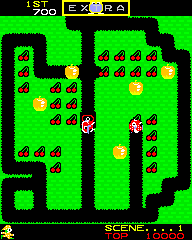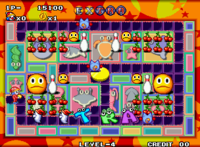
Mr. Do!
Encyclopedia
Mr. Do! is an arcade game
created by Universal
in 1982. Remotely similar in gameplay to Namco
's popular Dig Dug
title, Mr. Do! was also popular and saw release on a variety of home video game console
s and systems. It is the first game in the Mr. Do series
, and was released both as a standalone game and as a conversion kit (released by Taito Corp.
) for existing arcade cabinets. It was the first arcade game to be released as a conversion kit, and went on to sell 30,000 units in the United States.
 The object of Mr. Do! is to score as many points as possible by digging tunnels through the ground and collecting cherries. The title character, Mr. Do (a circus clown), is constantly chased by red monsters resembling small dinosaurs, and the player loses a life if Mr. Do is caught by one. The game is over when the last life is lost.
The object of Mr. Do! is to score as many points as possible by digging tunnels through the ground and collecting cherries. The title character, Mr. Do (a circus clown), is constantly chased by red monsters resembling small dinosaurs, and the player loses a life if Mr. Do is caught by one. The game is over when the last life is lost.
Cherries are distributed throughout the level in groups of eight. 500 bonus points are awarded if Mr. Do collects eight cherries in a row without stopping. A level is complete when all cherries are removed, all monsters are destroyed, "EXTRA" is spelled, or a diamond is found.
Mr. Do can defeat the monsters by hitting them with his bouncing "power ball" or by dropping large apples on them. While the power ball is bouncing toward a monster, Mr. Do is defenseless, leaving him vulnerable. If the ball bounces into an area where there are no monsters to hit (such as behind a fallen apple), Mr. Do cannot use it again until he has retrieved it. When the power ball hits a monster, it then reforms in Mr. Do's hands after a delay that increases with each use.
If an apple lands on a monster, or falls more than its own height, it breaks and disappears. If an apple drops a short distance and does not break, Mr. Do or the red monsters can push it off the edge of a vertical tunnel and crush one or more monsters. Mr. Do can also be crushed by a falling apple causing a loss of life.
Occasionally, the red monsters transform briefly into slower, more powerful multicolored monsters that can tunnel through the ground. If one of these digs through a cherry, it leaves fewer cherries (and fewer points) for Mr. Do to collect. When it digs under an apple, it often crushes itself, other red/blue monsters, and/or Mr. Do.
Each time the score passes a certain threshold during play (5000 points), a letter from the word "EXTRA" appears on the playfield as an Alphamonster, and the player can defeat or be defeated by this monster in the same way as a red monster. Defeating an Alphamonster awards that letter to the player, and collecting all five letters of the word completes the level, plays a cut scene inexplicably playing the theme to Astro Boy, and awards the player an extra life. Alphamonsters attempt to eat any apples they encounter, which makes them difficult (but not impossible) to crush.
The red monsters pop up from a generator at the center of the screen. After they have all appeared, the generator will turn into a food item; picking this up scores bonus points, freezes all the red monsters, and calls out an Alphamonster and three large blue monsters. The latter can eat apples as well. The red monsters stay frozen (but still deadly) until the player either defeats all three blue monsters, defeats the Alphamonster (in which case any remaining blue monsters are turned into apples), loses a life, or completes the stage.
Rarely, dropping an apple will reveal a diamond which, if collected within about 15 seconds, completes the level and awards a bonus credit to the player (as well as 8000 points), allowing him or her to play a free game. (This feature is relatively uncommon among arcade video games, though it is a standard feature of many pinball
machines.)
 Mr. Do!, like many games of its time, has been ported
Mr. Do!, like many games of its time, has been ported
to a variety of computer systems and video game console
s, including the Atari 2600
, several Atari 8-bit home computers
, the ColecoVision
, Apple II
, MSX
, Tomy Tutor
and the Commodore 64
series of computers. The game has also been adapted to more advanced systems, including Nintendo's Game Boy
and Super NES
(providing some new gameplay features), and a standalone handheld LCD
adaptation was released by Tomy
in 1983. Each port offers varying differences in gameplay from the arcade version, the most common of which is the fact that the bonus credit awarded by the diamond has been removed. The game has also seen numerous unauthorized clones released for various hardware platforms.
A completely new version of the game, Neo Mr. Do!, was released for SNK
's Neo Geo
system in 1996.
There is also a scheduled release of the arcade version on the Wii
Virtual Console
released in Japan on April 27, 2010.
Arcade game
An arcade game is a coin-operated entertainment machine, usually installed in public businesses such as restaurants, bars, and amusement arcades. Most arcade games are video games, pinball machines, electro-mechanical games, redemption games, and merchandisers...
created by Universal
Aruze
, is a Japanese manufacturer of pachinko, slot machines, arcade games and other gaming products, and a publisher of video games. Aruze possesses licenses to both manufacture and distribute casino machines in the American states of Nevada, Mississippi and New Jersey. The company's corporate...
in 1982. Remotely similar in gameplay to Namco
Namco
is a Japanese corporation best known as a former video game developer and publisher. Following a merger with Bandai in September 2005, the two companies' game production assets were spun off into Namco Bandai Games on March 31, 2006. Namco Ltd. was re-established to continue domestic operation of...
's popular Dig Dug
Dig Dug
is an arcade game developed and published by Namco in Japan in 1982 for Namco Galaga hardware. It was later published outside of Japan by Atari. A popular game based on a simple concept, it was also released as a video game on many consoles.-Objective:...
title, Mr. Do! was also popular and saw release on a variety of home video game console
Video game console
A video game console is an interactive entertainment computer or customized computer system that produces a video display signal which can be used with a display device to display a video game...
s and systems. It is the first game in the Mr. Do series
Mr. Do series
The Mr. Do series were a series of arcade games that revolved around a fictional clown, Mr. Do. The two most popular Mr. Do games were Mr. Do! and Mr. Do's Castle. The other two games, Mr. Do's Wild Ride and Do! Run Run were not as popular....
, and was released both as a standalone game and as a conversion kit (released by Taito Corp.
Taito Corporation
The is a Japanese publisher of video game software and arcade hardware wholly owned by publisher Square Enix. Taito has their headquarters in the Shinjuku Bunka Quint Building in Yoyogi, Shibuya, Tokyo, sharing the facility with its parent company....
) for existing arcade cabinets. It was the first arcade game to be released as a conversion kit, and went on to sell 30,000 units in the United States.
Game play

Cherries are distributed throughout the level in groups of eight. 500 bonus points are awarded if Mr. Do collects eight cherries in a row without stopping. A level is complete when all cherries are removed, all monsters are destroyed, "EXTRA" is spelled, or a diamond is found.
Mr. Do can defeat the monsters by hitting them with his bouncing "power ball" or by dropping large apples on them. While the power ball is bouncing toward a monster, Mr. Do is defenseless, leaving him vulnerable. If the ball bounces into an area where there are no monsters to hit (such as behind a fallen apple), Mr. Do cannot use it again until he has retrieved it. When the power ball hits a monster, it then reforms in Mr. Do's hands after a delay that increases with each use.
If an apple lands on a monster, or falls more than its own height, it breaks and disappears. If an apple drops a short distance and does not break, Mr. Do or the red monsters can push it off the edge of a vertical tunnel and crush one or more monsters. Mr. Do can also be crushed by a falling apple causing a loss of life.
Occasionally, the red monsters transform briefly into slower, more powerful multicolored monsters that can tunnel through the ground. If one of these digs through a cherry, it leaves fewer cherries (and fewer points) for Mr. Do to collect. When it digs under an apple, it often crushes itself, other red/blue monsters, and/or Mr. Do.
Each time the score passes a certain threshold during play (5000 points), a letter from the word "EXTRA" appears on the playfield as an Alphamonster, and the player can defeat or be defeated by this monster in the same way as a red monster. Defeating an Alphamonster awards that letter to the player, and collecting all five letters of the word completes the level, plays a cut scene inexplicably playing the theme to Astro Boy, and awards the player an extra life. Alphamonsters attempt to eat any apples they encounter, which makes them difficult (but not impossible) to crush.
The red monsters pop up from a generator at the center of the screen. After they have all appeared, the generator will turn into a food item; picking this up scores bonus points, freezes all the red monsters, and calls out an Alphamonster and three large blue monsters. The latter can eat apples as well. The red monsters stay frozen (but still deadly) until the player either defeats all three blue monsters, defeats the Alphamonster (in which case any remaining blue monsters are turned into apples), loses a life, or completes the stage.
Rarely, dropping an apple will reveal a diamond which, if collected within about 15 seconds, completes the level and awards a bonus credit to the player (as well as 8000 points), allowing him or her to play a free game. (This feature is relatively uncommon among arcade video games, though it is a standard feature of many pinball
Pinball
Pinball is a type of arcade game, usually coin-operated, where a player attempts to score points by manipulating one or more metal balls on a playfield inside a glass-covered case called a pinball machine. The primary objective of the game is to score as many points as possible...
machines.)
Ports and sequels

Porting
In computer science, porting is the process of adapting software so that an executable program can be created for a computing environment that is different from the one for which it was originally designed...
to a variety of computer systems and video game console
Video game console
A video game console is an interactive entertainment computer or customized computer system that produces a video display signal which can be used with a display device to display a video game...
s, including the Atari 2600
Atari 2600
The Atari 2600 is a video game console released in October 1977 by Atari, Inc. It is credited with popularizing the use of microprocessor-based hardware and cartridges containing game code, instead of having non-microprocessor dedicated hardware with all games built in...
, several Atari 8-bit home computers
Atari 8-bit family
The Atari 8-bit family is a series of 8-bit home computers manufactured from 1979 to 1992. All are based on the MOS Technology 6502 CPU and were the first home computers designed with custom coprocessor chips...
, the ColecoVision
ColecoVision
The ColecoVision is Coleco Industries' second generation home video game console which was released in August 1982. The ColecoVision offered arcade-quality graphics and gaming style, and the means to expand the system's basic hardware...
, Apple II
Apple II
The Apple II is an 8-bit home computer, one of the first highly successful mass-produced microcomputer products, designed primarily by Steve Wozniak, manufactured by Apple Computer and introduced in 1977...
, MSX
MSX
MSX was the name of a standardized home computer architecture in the 1980s conceived by Kazuhiko Nishi, then Vice-president at Microsoft Japan and Director at ASCII Corporation...
, Tomy Tutor
Tomy Tutor
The Tomy Tutor was a home computer produced by the Japanese toymaker Tomy. It was architecturally similar- but not identical- to the Texas Instruments TI-99/4A, and used a similar 16-bit CPU. The computer was launched on the UK and European markets in late 1983...
and the Commodore 64
Commodore 64
The Commodore 64 is an 8-bit home computer introduced by Commodore International in January 1982.Volume production started in the spring of 1982, with machines being released on to the market in August at a price of US$595...
series of computers. The game has also been adapted to more advanced systems, including Nintendo's Game Boy
Game Boy
The , is an 8-bit handheld video game device developed and manufactured by Nintendo. It was released in Japan on , in North America in , and in Europe on...
and Super NES
Super Nintendo Entertainment System
The Super Nintendo Entertainment System is a 16-bit video game console that was released by Nintendo in North America, Europe, Australasia , and South America between 1990 and 1993. In Japan and Southeast Asia, the system is called the , or SFC for short...
(providing some new gameplay features), and a standalone handheld LCD
Liquid crystal display
A liquid crystal display is a flat panel display, electronic visual display, or video display that uses the light modulating properties of liquid crystals . LCs do not emit light directly....
adaptation was released by Tomy
TOMY
is a Japanese toy, children's merchandise and entertainment company created from the March 2006 merger of two companies: Tomy and long-time rival, Takara...
in 1983. Each port offers varying differences in gameplay from the arcade version, the most common of which is the fact that the bonus credit awarded by the diamond has been removed. The game has also seen numerous unauthorized clones released for various hardware platforms.
A completely new version of the game, Neo Mr. Do!, was released for SNK
SNK
SNK is a former name of SNK Playmore, a Japanese video game company . This may also refer to:* SNK European Democrats* SNK Union of Independents* Southeast Airlines ICAO code...
's Neo Geo
Neo Geo (console)
The is a cartridge-based arcade and home video game system released on July 1, 1991 by Japanese game company SNK. Being in the Fourth generation of Gaming, it was the first console in the former Neo Geo family, which only lived through the 1990s...
system in 1996.
There is also a scheduled release of the arcade version on the Wii
Wii
The Wii is a home video game console released by Nintendo on November 19, 2006. As a seventh-generation console, the Wii primarily competes with Microsoft's Xbox 360 and Sony's PlayStation 3. Nintendo states that its console targets a broader demographic than that of the two others...
Virtual Console
Virtual console
A virtual console – also known as a virtual terminal – is a conceptual combination of the keyboard and display for a computer user interface. It is a feature of some operating systems such as UnixWare, Linux, and BSD, in which the system console of the computer can be used to switch between...
released in Japan on April 27, 2010.
External links and sources
(retrieved February 9, 2005)- The Arcade Flyer Archive entry for Mr. Do!
- arcade-history.com entry on Mr. Do! (retrieved February 11, 2005)

